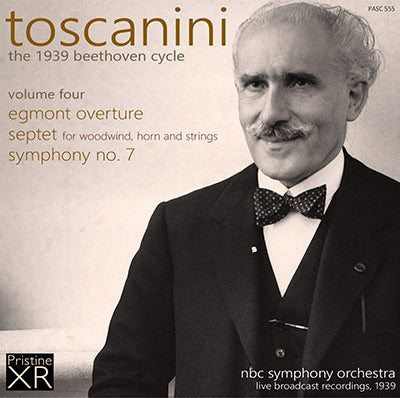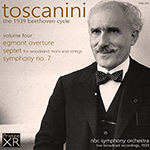
This album is included in the following sets:
This set contains the following albums:
- Producer's Note
- Full Track Listing
- Cover Art
- New York Times Review
On 28 October 1939, Arturo Toscanini took to the podium with his NBC Symphony Orchestra to begin what would be a unique series of six concerts: his only recorded Beethoven integral symphony cycle. Over six weekly concert broadcasts Toscanini would conduct all nine symphonies, roughly in order, together with various overtures, excerpts and other works, most interestingly the Choral Fantasy, Op. 80. This was coupled with the Ninth "Choral" Symphony in a special broadcast live from Carnegie Hall (the other concerts took place in his more usual radio studio venue), and constitutes the only recorded example of him conducting this work ever. Mortimer H. Frank suggests that Toscanini considered conducting the work again in 1952 in London but dropped the idea - he also suggests this may have been the only time Toscanini ever conducted the Choral Fantasy.
As with our recent issues of Toscanini conducting Russian music (PASC548) and the music of Richard Strauss (PASC549), I have been able to access source recordings of unprecedented quality, taken from acetate discs recorded directly by NBC and almost certainly not played since. For optimal sound quality this is crucial - the delicate surfaces of these discs are prone to immediate deterioration when played, especially when the weighty pick-ups in common use in the 1940s were used, resulting in distortion, higher background noise, and potential loss of high frequencies and other details. Previous issues have relied on Toscanini's own copies, discs which have seen considerable wear and use over the years.
The use of these new
source discs translates directly into remarkable audio quality, with
quiet backgrounds and a particularly wide frequency range - and sound
quality that would have been considered excellent on a hi-fi era LP
record from twenty or more years later. The use of the latest audio
restoration technology brings with it rock-solid pitching, excellent
tonal balance, and a clean, clear sound quality throughout. On the
present volume I had to contend with both wow and flutter throughout the recording, and also two different pitches caused by the disc cutters running at different speeds. There was also a degree of pitch drift to be seen across sides. Cumulatively this resulted in differences of up to a semitone in pitch between the highest and lowest points of the recording, and a section of around four minutes where the pitch slowly rose by almost this amount.
Each of the concert broadcasts ran for longer than was usual, and it has been necessary to trim some of the commentary from these recordings in order to fit each one onto a single CD release without cutting any of the music. The amount of speech editing will vary from release to release, but the intention is to preserve as much as possible the occasion as heard some 80 years ago - this is, we believe, the first time they have been presented as broadcast in this manner. Certainly they have never sounded as fresh and fine as this before.
1. RADIO Opening Announcement (0:37)
2. BEETHOVEN Egmont, Op. 84 (8:21)
3. RADIO Midway Announcement 1 (1:02)
BEETHOVEN Septet in E flat for Woodwind, Horn & Strings, Op. 20
4. 1st mvt. - Adagio - Allegro con brio (8:00)
5. 2nd mvt. - Adagio cantabile (8:25)
6. 3rd mvt. - Tempo di menuetto - Trio (3:10)
7. 4th mvt. - Tema con variazioni. Andante (7:34)
8. 5th mvt. - Scherzo. Allegro molto e vivace - Trio (2:59)
9. 6th mvt. - Andante con molto alla marcia - Presto (5:27)
10. RADIO Midway Announcement 2 (0:38)
BEETHOVEN Symphony No. 7 in A, Op. 92
11. 1st mvt. - Poco sostenuto - Vivace (11:19)
12. 2nd mvt. - Allegretto (8:08)
13. 3rd mvt. - Presto (6:51)
14. 4th mvt. - Allegro con brio (6:40)
15. RADIO Closing Announcement (0:44)
NBC Symphony Orchestra
conducted by Arturo Toscanini
XR remastering by Andrew Rose
Cover artwork based on a photograph of Toscanini
Broadcast of 18 November, 1939
NBC Studio 8H, Radio City, New York
Total duration: 79:55
TOSCANINI DIRECTS BEETHOVEN SEPTET
Chamber Work, With Strings Reinforced, Feature of 4th NBC Cycle Concert
GIVES ‘EGMONT’ OVERTURE
Also Makes a Characteristic innovation in Scherzo of the Symphony in A Major
By OLIN DOWNES
Perhaps those who listen to an instrumental concert by means of the radio get the greatest rewards from the scores which employ but a few instruments, as, for example, the Beethoven septet, which, with reinforced strings, was performed by the NBC Symphony Orchestra under Toscanini's direction last night in Studio H-8 in Radio City in the fourth concert in the Beethoven cycle. At least, this principle holds true if Toscanini directs the performance.
He is pre-eminent in music which requires the clarity, artistocratic grace and inherent power of the representative scores of the Haydn-Mozart and early Beethoven period. Much of the Septet might be Haydn, were it not for a new compression, energy and humor which entered music with Beethoven, It was a common mistake of even a quarter of a century ago to refer condescendingly to the early scores of the Bonn master, but Toscanini always knew better. He makes of each phrase a masterpiece.
Mr. Toscanini would probably agree with the Arabian philosopher who discovered in a small ring the reflection of the completeness of the universe. Here, in simple melodic lines and small dimensioned forms, are the profound formal ideas which underly the symphonies. The enchanting simplicity of the Septet, in a word, is matched by its consumate workmanship. To achieve a like simplicity and mastery in performance is an accomplishment of only secondary magnitude.
Mr. Toscanini accomplished this so felicitously that at times one wanted to
laugh aloud in sheer exhilaration at his achievement. There were not only
grace and wit, but also a pervasive beauty of song in the playing which
provided the last essential of a great interpretation. Thirty strings
replaced Beethoven’s four. These thirty proved that they could play, not
like four, but like one.
The utter absence of bombast or mere dramatic rhetoric, and the quintessence of drama and heroism in the “Egmont” score were precisely reflected in the performance. The Beethoven Seventh Symphony had the same unsurpassable sincerity and complete absence of effect for effect’s sake, or for any reasons save those both implicit and explicit in the score.
It would be interesting, one of these days, if that rare being, the conductor who loves Beethoven but fears him as he does his God, should attempt a small editing to obtain somewhat better balances in the orchestration of the symphony's introduction, where the wind parts, with the noble swinging motive in half notes, are in certain measures not strong enough to balance properly the ascending sixteenths of the strings. That is Beethoven’s shortcoming.
Mr. Toscanini, as usual, takes the trio of the scherzo of the symphony faster than is customary. The more one hears this, the more it seems logical, and no injustice to the music. He made no attempt to read special things into the uproarious finale, built principally on the Nora McCruna song. He gave the music its head, and we were richly rewarded.
New York Times, 19 November, 1939
Classical Source review
A profoundly moving and humbling experience

